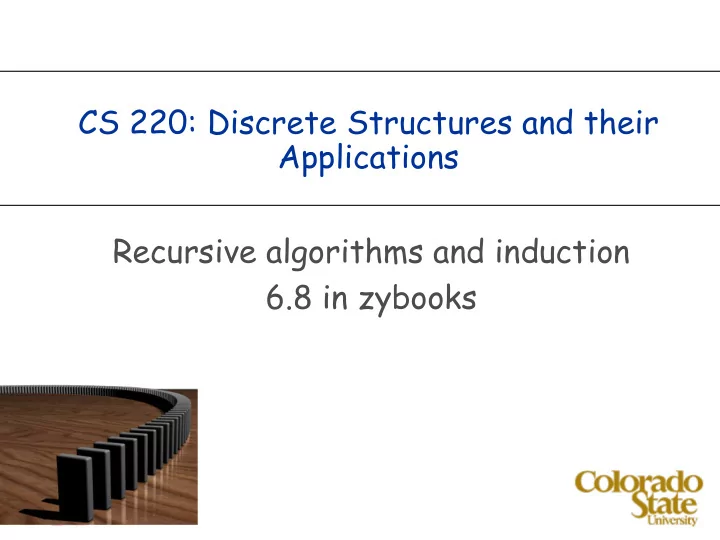

CS 220: Discrete Structures and their Applications Recursive algorithms and induction 6.8 in zybooks
Induction and Recursion Several of the inductive proofs we looked at lead to recursive algorithms: ■ The triomino tiling problem ■ Making postage using 3 and 5 cent stamps ■ Generating all subsets of a set recursively Induction is useful for designing and proving the correctness of recursive algorithms
String reversal Consider the following recursive algorithm for reversing a string: reverse_string(s) if s is the empty string: return s let c be the first character in s remove c from s s' = reverse_string(s) return the string s' with c added to the end
String reversal Proof of correctness of reverse_string reverse_string(s) if s is the empty string: return s let c be the first character in s remove c from s s' = reverse_string(s) return the string s' with c added to the end By induction on the length of the string Base case: If s has length 0 the algorithm returns s which is its own reverse.
String reversal Proof of correctness of reverse_string reverse_string(s) if s is the empty string: return s let c be the first character in s remove c from s s' = reverse_string(s) return the string s' with c added to the end Inductive step: assume that reverse_string works correctly for strings of length k and show that for k+1 Let s be a string of length k + 1. s = c 1 c 2 …c k c k+1 . reverse_string makes a recursive call whose input is c 2 …c k c k+1 . By the induction hypothesis it returns the inverse: c k+1 c k …c 2 It then adds c 1 at the end, returning c k+1 c k …c 2 c 1 , which is the reverse of s
recursive power def pow(x, n): #precondition: x and n are positive integers if (n == 0): return 1 else : return x * pow(x, n-1) } }
recursive power def pow(x, n): #precondition: x and n are positive integers if (n == 0): return 1 else : return x * pow(x, n-1) Claim: the algorithm correctly computes x n . Proof: By induction on n Basis step: n = 0: it correctly returns 1 Inductive step: assume that for n the algorithm correctly returns x n . Then for n+1 it returns x x n = x n+1 .
Egyptian Exponentiation In PA2 you are implementing an iterative exponentiation algorithm, based on the following recursive definition: def pow(x, n): #precondition: x and n are positive integers if n == 0: return 1 else if not (n/2 == n//2): return x * pow(x**2, n//2) else: return pow(x**2, n//2) Does linear induction work for this algorithm? Why (not) ? What do we need?
the power set def powerset(s) : if len(s) == 0: return {frozenset()} else : element = s.pop() pwrset = powerset(s) return pwrset.union({ x.union({element}) for x in pwrset})
Recommend
More recommend